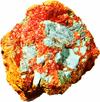- arsenic
-
n. /ahr"seuh nik, ahrs"nik/; adj. /ahr sen"ik/, n.1. a grayish-white element having a metallic luster, vaporizing when heated, and forming poisonous compounds. Symbol: As; at. wt.: 74.92; at. no.: 33.3. a mineral, the native element, occurring in white or gray masses.adj. arsenic4. of or containing arsenic, esp. in the pentavalent state.[1350-1400; ME arsenicum < L < Gk arsenikón orpiment, n. use of neut. of arsenikós virile (ársen male, strong + -ikos -IC), prob. alter. of Oriental word (perh. < *arznig, metathetic var. of Syriac zarnig) by folk etym.]
* * *
It exists uncombined in two stable (and several unstable) allotropes, one gray and one yellow, but is more often found in nature as the sulfide or oxide. The elemental form is used to form alloys of metals (especially lead), and certain semiconductors are made from crystals of gallium arsenide (GaAs). Arsenious oxide (arsenic trioxide or white arsenic, As2O3) is used in pesticides, as a pigment, and as a preservative of hides and wood; this is the poisonous "arsenic" (see arsenic poisoning) in detective stories. Arsenic pentoxide (As2O5) is also used in insecticides, herbicides, metal adhesives, and pigments. By courtesy of the Joseph and Helen Guetterman collection; photograph, John H. Gerard
By courtesy of the Joseph and Helen Guetterman collection; photograph, John H. Gerard* * *
Introductiona chemical element in the nitrogen family (Group Va of the periodic table), existing in both gray and yellow crystalline forms. Although compounds of arsenic were known as early as the 4th century BC, the element was not identified as such until 1649.Occurrence, properties, and usesArsenic is widely distributed in nature, and this element occasionally is found uncombined, generally in association with such metals as antimony and silver. Arsenic also occurs combined in its sulfides realgar and orpiment, as arsenic oxide, and as a constituent of various metallic sulfides, of which arsenopyrite is the most abundant.Although some forms of elemental arsenic are metal-like, the element is best classified as a nonmetal. Gray, or metallic, arsenic, which is more stable and more common than the softer yellow form, is very brittle, tarnishes in air, and sublimes when heated strongly—i.e., it passes directly into a vapour without melting and reverts to the crystalline solid without liquefying upon cooling the vapour. In addition to gray and yellow arsenic, other forms (allotropes) have been reported.Elemental arsenic has few practical uses, one of which is to impart more nearly spherical shape in the manufacture of lead shot. It is also used in certain alloys to increase strength at elevated temperatures, in bronzing, and in pyrotechnics. All naturally occurring arsenic consists of the stable isotope arsenic-75; the radioactive isotopes arsenic-72, -74, and -76 have been used in medical diagnostic procedures.Principal compoundsBecause arsenic has a range of oxidation states from -3 to +5, it can form a variety of different kinds of compounds. Among the most important commercial compounds are the oxides, the principal forms of which are arsenious oxide (As4O6) and arsenic pentoxide (As2O5). Arsenious oxide, commonly known as white arsenic, is obtained as a by-product from the roasting of the ores of copper, lead, and certain other metals as well as by the roasting of arsenopyrite and arsenic sulfide ores. Arsenious oxide provides the starting material for most other arsenic compounds. It is also utilized in pesticides and serves as a decolourizer in the manufacture of glass and as a preservative for hides. Arsenic pentoxide is formed by the action of an oxidizing agent (e.g., nitric acid) on arsenious oxide. It comprises a major ingredient of insecticides, herbicides, and metal adhesives.arsine (AsH3), a colourless poisonous gas composed of arsenic and hydrogen, is another familiar arsenic compound. The gas, also called arsenic hydride, is produced by the hydrolysis of metal arsenides and by the reduction by metals of arsenic compounds in acidic solutions. It has been used as a doping agent for semi-conductors and as a military poison gas. Arsenic compounds of particular importance in agriculture are arsenic acid (H3AsO4) and such salts as lead arsenate (PbHAsO4) and calcium arsenate [Ca3(AsO4)2], which are useful for sterilizing soils and controlling pests, respectively.Arsenic also forms numerous organic compounds, as for example tetramethyl diarsine, (CH3)2As−As(CH3)2, used in preparing the common desiccant cacodylic acid. Several complex organic compounds of arsenic have been employed in the treatment of certain diseases, such as amebic dysentery, caused by microorganisms.atomic number33atomic weight74.9216melting point(gray form)814° C (1,497° F) at36 atmospheres pressuredensity(gray form)5.73 g/cm3 at 14° C (57° F)(yellow form)2.03 g/cm3 at 18° C (64° F)oxidation states-3, +3, +5electron config.1s22s22p63s23p63d104s24p3* * *
Universalium. 2010.
